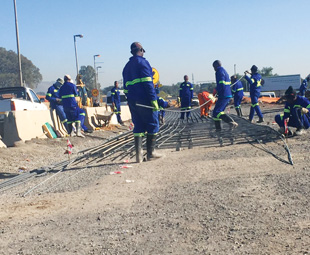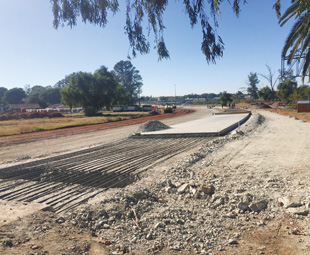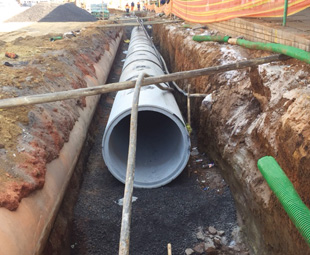North West eager for new transport system

In February this year, the Rustenburg municipality began road construction in the CBD to prepare for the area’s new bus rapid transit system. WILLIAM GEORGE looks at the progress and the future plans for this service in the North West province
North West is one of the latest provinces to introduce plans of integrated transport through bus rapid transit (BRT). This follows KwaZulu-Natal’s plans to launch its Go!Durban BRT service.
The Rustenburg rapid transit (RRT) system, branded as Yarona, aims to provide an integrated public transport facility that is safe, affordable, efficient and located within easy reach of local commuters’ homes.
The Rustenburg municipality falls under the Bojanala Platinum District, which has a population of over 600 000 residents and covers an area of approximately 3 500 km² and a total of 43 wards.
Yarona bus service to reach the majority of the population
Obed Moleele, the unit manager of business development for the Rustenburg Roads and Transport Directorate, says that the Yarona bus service is expected to be used by up to 44 000 people per day.
 “The Rustenburg municipality is implementing the project within its jurisdiction. The plan is to make it available to 85 percent of the municipality’s population,” he says.
“The Rustenburg municipality is implementing the project within its jurisdiction. The plan is to make it available to 85 percent of the municipality’s population,” he says.
The project operations were introduced in four phases in 2016. The system will be phased in over the next ten years, with current infrastructure for corridors A and B (which are 5,3 km and about 13 km long, respectively) now completed.
The development and implementation of the Yarona service follows the guidelines from the National Transport Policy by the Depatment of Transport and the Integrated Transport Plan for the Rustenburg municipality.
“The system has been designed in detail from the beginning of the project as a fully intergrated public transport network. The first Go-Live phase will assist in the introduction of subsequent phases.
Moleele explains that the first phase of the Yarona service will launch in 2018 and will serve the residents of Rustenburg through an integrated transport network that will include BRT trunk corridors, direct routes and feeder services.
It is expected that the Yarona service will have positive spin-offs. These include the trunk corridor, which consists of the two highest-demand transport corridors: the R510 from Kanana to Rustenburg CBD; and the R565/R104 from Phokeng to Rustenburg CBD.
These two corridors form the trunk corridor that forms a “V” and links many communities to the CBD and to the mining industries within the region,” says Moleele.
A total of six stations for the Go-Live phase are almost completed. There are nine feeder routes and top locations that are being verified.
The construction of facilities for non-motorised transport commenced in March along with feeder routes. Ultimately, the CBD stations will be redesigned while construction for sections A, C and B has commenced.
“All trunk stations will have level boarding platforms and will be universally accessible. The trunk stations need to be fully integrated with pedestrian and cycle networks with bicycle parking at key stations,” Moleele says.
Ongoing collaboration with the community and transport industry
 On the eastern part of North West province, there is a long-running service of Bojanala buses that need to be taken into account when implementing the new bus service.
On the eastern part of North West province, there is a long-running service of Bojanala buses that need to be taken into account when implementing the new bus service.
Moleele comments: “Bojanala forms part of all negotiations with the industry and no challenges are being faced by the municipality as far as the transition and negotiations with the industry are concerned.
“Expectations have been raised in the city. The taxi and bus operators are actively participating and the communities are eager to have new public transport system.”
He continues: “As early as 2012, and even prior to the finalisation of the RRT network and operational plan, the municipality started engaging with the taxi industry with the sole purpose of getting an in-principle understanding by the taxi industry of the BRT concept and its potential impact on their current business. The taxi industry is now more than willing to see the implementation and the success of the new transport system.”
Job opportunities created through Yarona
The development of infrastructure for Yarona has created numerous job and training opportunities for people in Rustenburg. “An initial 946 jobs were created on the project with preference given to locals at the inception of construction,” Moleele notes.
The project is continuing to create more employment opportunities for many people on the routes where Yarona will operate.
The Rustenburg Rapid Transit Directorate recently completed a register of residents and owners of
small, medium and micro enterprises in the
municipality’s unemployment and supplier database, which will be used when opportunities arise as part of the Yarona services.
A database of 1 044 unemployed residents was also created with several employment opportunities to be realised as the phases are rolled out. These include: bus drivers, bus cleaners, queue marshals, inspectors, infrastructure maintenance staff, security officers, depot staff and communications personnel.
A career-guidance book was also produced and is available in print and on the buses.
Fully integrated system with pedestrian and cycling options
According to the municipality, over 80 percent of Rustenburg’s residents rely on public transport for mobility and to access economic opportunities and social services.
Moleele says that the Yarona system will substantially improve public transport service delivery and will support other key city goals and strategies.
According to Linda Hlotshwayo, marketing communications manager, roads and transport at Yarona, the service is expected to kick off in October 2018, depending on whether all systems are in place.
Published by
Focus on Transport
focusmagsa




